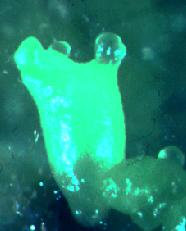In the presence of sufficiently high levels of exogenous auxin, somatic embryos of soybean fail to complete their histodifferentiation. Instead, they give rise to additional embryos from their apices, which allows their large-scale proliferation. The photos below show the earliest and later stages of repetitive embryogenesis.


The ability of somatic embryos to undergo proliferation from their apices was first noted in the following reference:
J. J. Finer. 1988. Apical proliferation of embryogenic tissue of soybean [Glycine max (L.) Merrill]. Plant Cell Rep. 7:238-241.
The ability to maintain apical proliferation in liquid medium has been described:
J. J. Finer and A. Nagasawa. 1988. Development of an embryogenic suspension culture of soybean (Glycine max Merrill). Plant Cell Tissue Organ Cult. 15:125-136.
The ability to maintain apical proliferation on MSD20 medium has been described:
J. A. Buchheim, S. M. Colburn, and J. P. Ranch. 1989. Maturation of soybean somatic embryos and the transition to plantlet growth. Plant Physiol. 89:768-775.
M. S. Wright, K. L. Launis, R. Novitzky, J. H. Duesing, and C. T. Harms. 1991. A simple method for the recovery of multiple fertile plants from individual somatic embryos of soybean [Glycine max (L.) Merrill]. In Vitro Cell.Dev.Biol. 27P:153-157.
